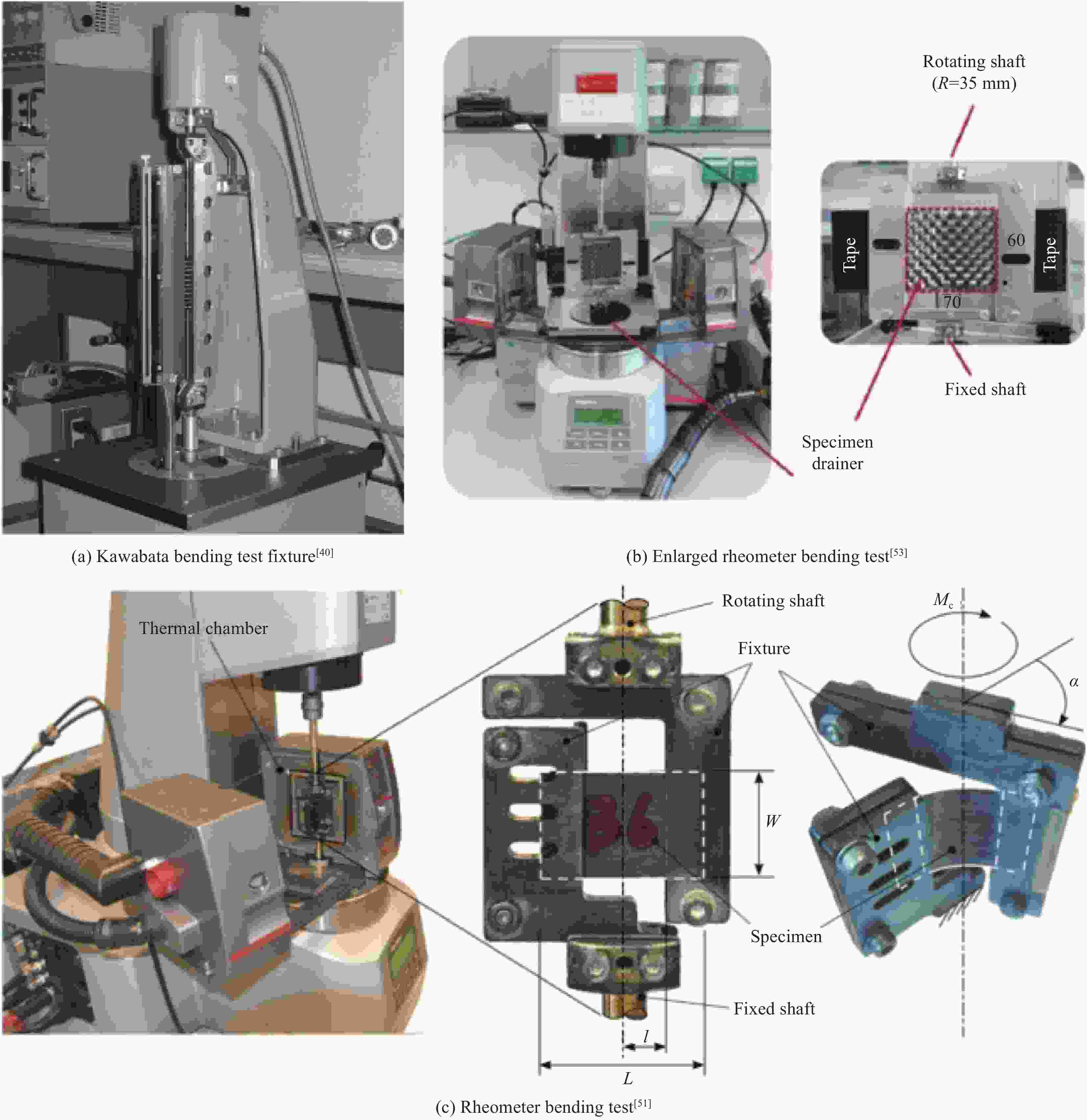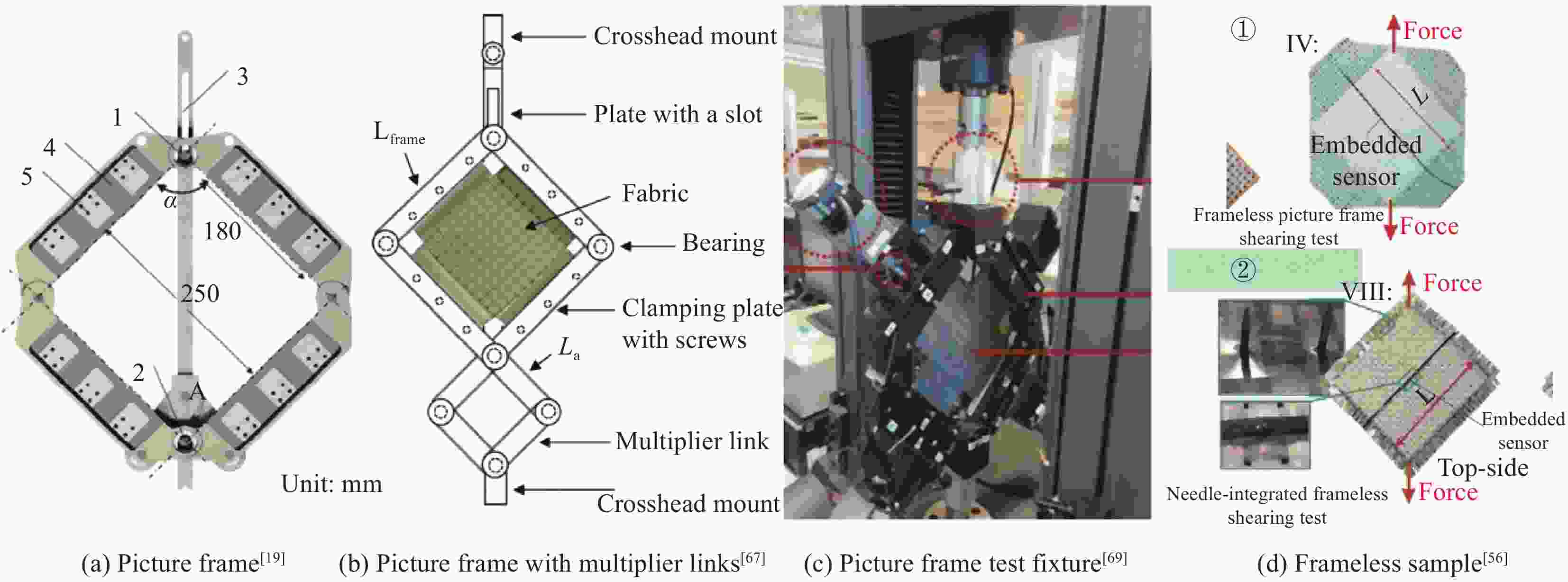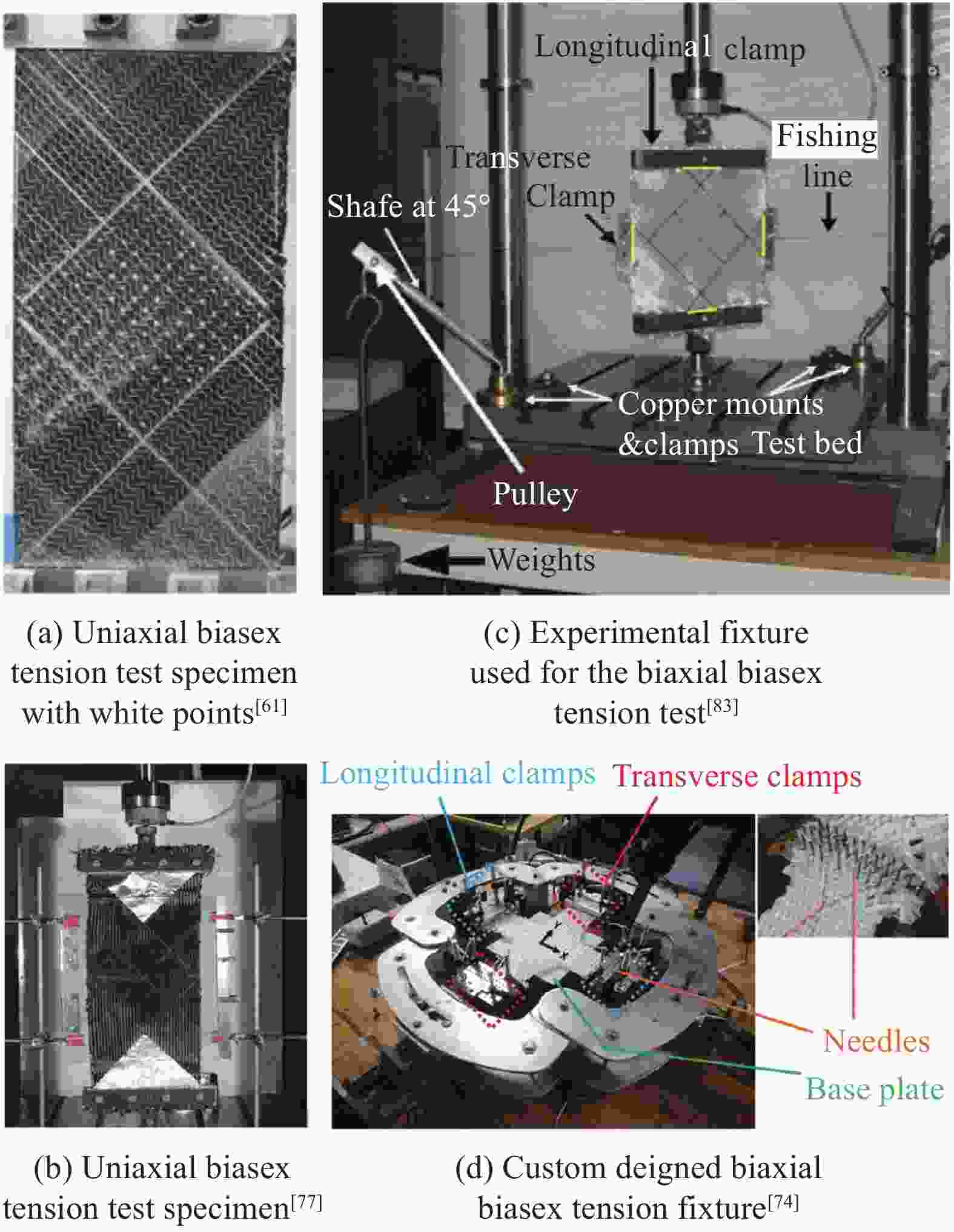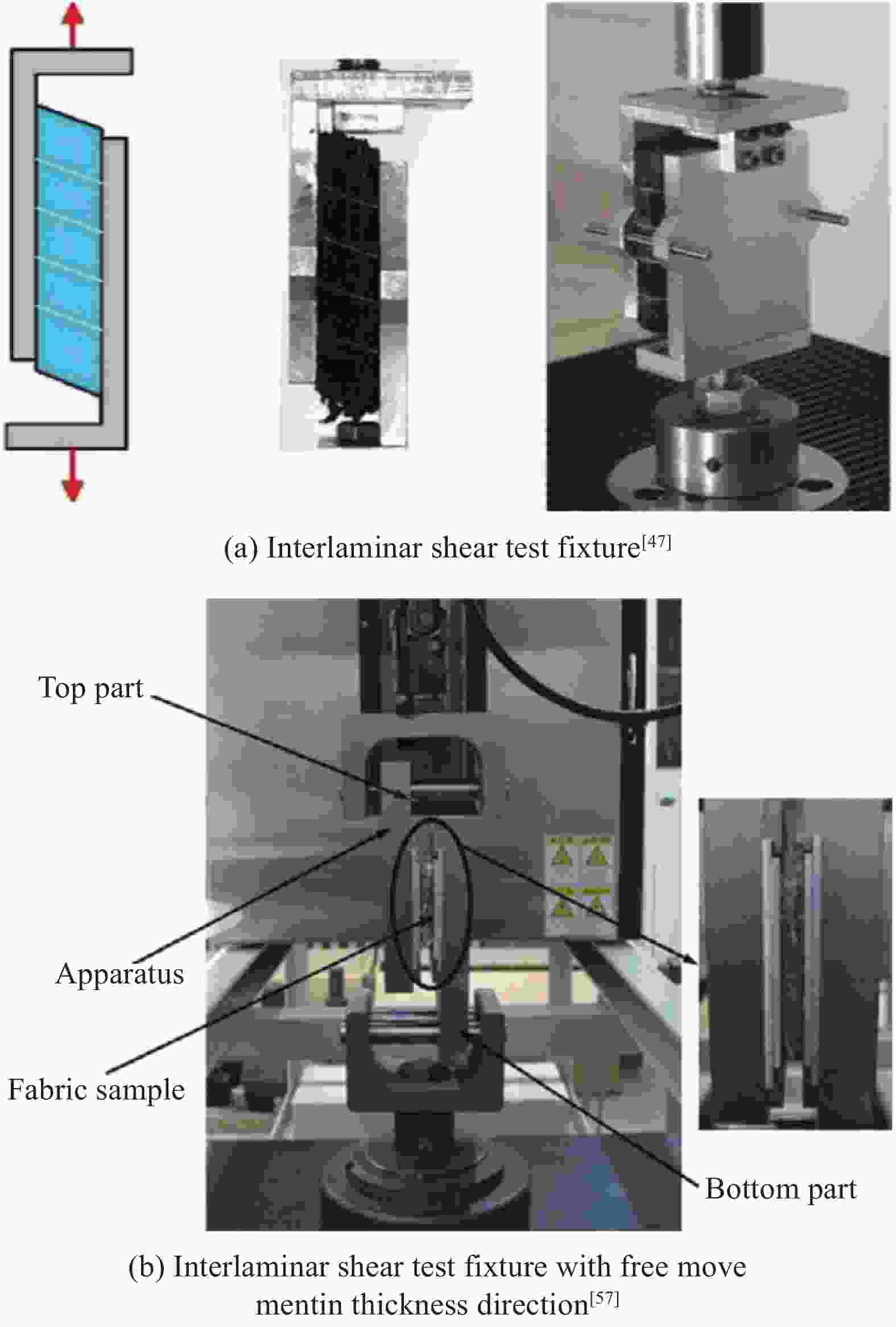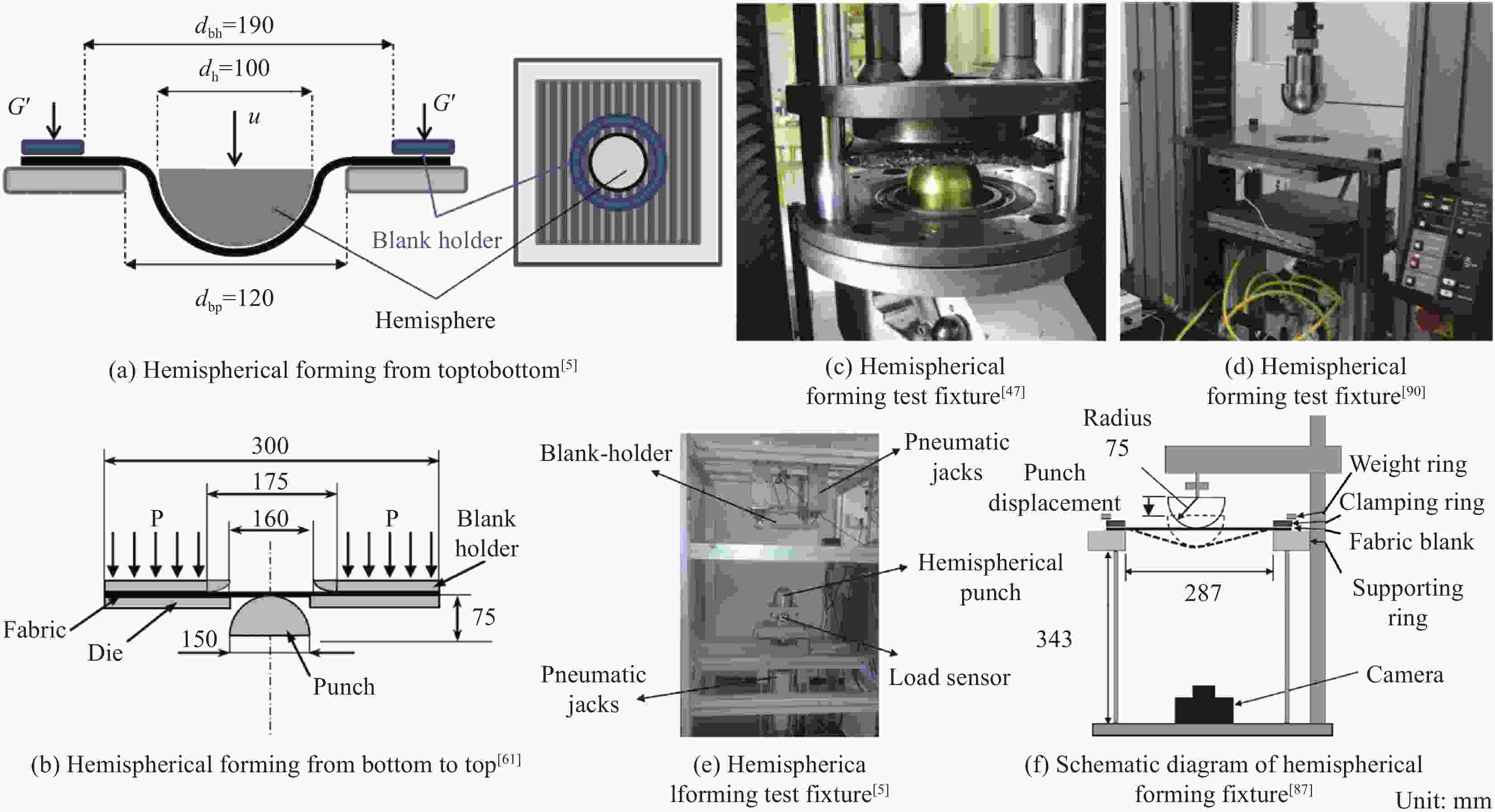Research progress in testing methods of mechanical properties of textile composite fiber preforms
-
摘要: 纺织复合材料具有质量轻、强度高,可设计性强等诸多优势,在航空航天领域得到广泛应用。纺织预制体的纤维结构对复合材料的最终力学性能有着决定性影响。然而,预制体的纤维结构在织造过程中不可避免地会发生宏观尺寸和微细观结构的变形,甚至产生褶皱缺陷。纺织预制体作为一种柔性骨架,其变形机制十分复杂。采用试验测试来表征预制体的力学变形特性是最直接、最有效的方法,也是建立理论和数值分析模型的基础。本文对纺织复合材料预制体的拉伸、压缩、弯曲、剪切和成型试验等测试方法进行了综述,讨论了不同测试方法的优缺点及适用条件,对后续的研究工作进行了展望。本研究将为预制体力学测试技术的改进、测试标准的建立和成型过程中的准确控形提供理论指导,对纺织复合材料的结构设计和工程应用起到推动作用。Abstract: Textile composites are widely used in aerospace field because of its advantages of light weight, high strength and strong designability.The fiber structure of textile preform determines the final mechanical properties of composites. However, the fiber structure of preform inevitably undergoes macro-scale and micro-structure deformation during the weaving process, and even wrinkle defects. The preform is a flexible skeleton, and its deformation mechanism is very complicated. Test is the most direct method to characterize the mechanical properties of preform, and it is also the basis of establishing theoretical and numerical analysis model. In this paper, the basic test methods of textile composite preform, such as tensile test, compression test, bending test, shear test and forming test, are reviewed. The advantages, disadvantages and applicable conditions of different test methods are discussed, and the future research work is prospected. The work in this paper will provide theoretical guidance for the improvement of preform mechanics testing technology, the establishment of testing standards and the accurate control of shape during the forming process. It will promote the structural design and engineering application of textile composites.
-
Key words:
- textile composites /
- preform /
- mechanical properties /
- test method /
- deformation mechanism
-
图 6 相框剪切和单向偏轴拉伸变形示意图[61]
Figure 6. Schematic representation of picture frame and uniaxial bias extension deformation[61]
Fframe—Measured force; Lframe—Length of the frame; γ12/2—Half shear angle; θ—Frame angle; Fshear—Shear force; Lfabric—Sample’s clamping length; uframe—Measured displacement; H—Effective length of specimen; L0—Initial diagonal length of zone A; d—Tensile displacement; Fbias—Tensile load; α—Half frame angle
表 1 双轴拉伸测试的试验参数
Table 1. Experimental parameters of biaxial tensile test
Material Sample center size/mm Sample arm size/mm Strain measurement method Loading method Ref. Coated woven fabrics 700×700 260×100 135 mm linear displacement transducers Biaxial bidirectional loading [16] Coated woven fabrics 300×300 150×25 100 mm linear displacement transducers Biaxial unidirectionalloading [16] Non-crimp 3D orthogonal woven reinforcement 60×60 145×60 Digital image correlation (DIC) Biaxial bidirectional loading [18] URETEK3216LV 160×160 200×160 28 mm needle extensometers Biaxial unidirectional loading [14] Envelope material 50×50 200×50 High-precision displacement sensors Plane loading of vertical specimen [19] HAA envelope 100×100 220×100 High-speed photography Biaxial bidirectional loading [12] Uretek5876 160×160 160×200 20 mm needle extensometers Biaxial bidirectional loading [15] Note: HAA—High altitude airship. 表 2 压缩测试的试验参数
Table 2. Experimental parameters of compression test
Material Top plate Sample
size/mmSpeed/
(mm·min-1)Strain measurement
methodRef. Spacer fabric Not mentioned 100×100 12 Micro-CT [30] Hexcel G986 twill 2/2 carbon fabric Diameter: 100 mm — 0.5 Micro-CT [23] Interlock fabric Not mentioned 100×100 1 Digital microscope VHX-1000 [21] 2/2 twill weave fabric Not mentioned 100×100 0.5 Micro-CT [31] Single layer fabric Surface areas: 15 cm2 50×50 1 Micro-CT [22] Woven and knitted fabrics Diameter: 100 mm 140×140 1 High resolution microscope [24] Carbon fibre plain weave Diameter: 50 mm 60×60 1 Imetrum video gauge system and Micro-CT [32] 表 3 弯曲测试的试验参数
Table 3. Experimental parameters of bending test
Material Test method Sample size/mm Speed Temperature/℃ Ref. Four structural carbon fiber fabrics Cantilever test 300×300 Quasi-static No [37] Monoply and multiply stitched fabric Cantilever test 300×150 Quasi-static No [40] Monoply/multiply and 3D carbon fiber fabric Cantilever test Monoply: 150/180×50
Multiply: 100×50
3D: 405×70×15Quasi-static No [41] PPS-carbon satin prepregs Cantilever test 200×50 Quasi-static 320, 345, 360, 380 [46] UHMWPE fiber reinforced TPU “Vertical”
cantilever test250×20 Quasi-static 80, 100, 120 [47] 5HS satin weave impregnated with Cycom 5320 “Vertical”
cantilever test150×50 3, 6, 9 mm/s 20, 50, 70, 90 [44] Unidirectional carbon
fiber reinforced PA6Cantilever/
three-point test23×15,53×15
Span: 20/500.01, 0.1, 0.5
mm/min200, 230, 260 [48] Interlock reinforcement Three-point test 200×30×15
Span: 116— No [49] Glass fiber twill/UD prepreg Rheometer test 15×20 0.1, 1, 10 r/min 60, 150, 210, 220, 260 [50] Unidirectional carbon
fiber reinforced Nylon 6Rheometer test (25-35)×25 0.6, 6, 19.2, 60 °/s 240, 26, 280 [51] Carbon fiber plain weave
fabric and Silicone oilsRheometer test 60×70 0.1, 1, 10 r/min No [52] Notes: PPS—Polyphenylene sulfite; TPU—Thermoplastic polyurethane; UHMWPE—Ultrahigh molecular weight polyethylene; UD—Unidirectional. 表 4 相框剪切测试的试验参数
Table 4. Experimental parameters of picture frame test
Material Sample size/mm Speed/(mm·min−1) Strain measurement method Ref. 3D angle interlock fabric 100×100 10 Manual image analysis [58] Non-crimp 3D orthogonal weave preform 180×180 10 Digital image correlation (DIC) [18] Plain-woven Kevlar@ 49 75×75
100×100
125×1255 CCD camera [67] NCFs with chain and tricot-chain stitches 210×210 20 1230-pixel camera [65] Twintex fabric 219×219 — Zeiss V20 stereo microscope [62] UD-NCF and Hexcel’s woven fabric 170×170 100 Two video cameras [61] F-12 aramid fabric 127×127 — DIC [66] Note: NCFs—Non-crimp fabrics. 表 5 偏轴拉伸测试的试验参数
Table 5. Experimental parameters of bias extension test
Material Test method Sample size/mm Speed/(mm·min−1) Strain measurement method Ref. 4-harness satin weave fabric and epoxy resin Bias extension test 225×90 20 DIC [78] Nylon 66 woven engineering fabric Bias extension test 200×100 10 CCD camera [56] Non-crimp 3D orthogonal weave preform Bias extension test 200×100 3 Digital camera [18] F-12 aramid fabric Bias extension test 300×50 — DIC [66] 2×2 twill-weave carbon fabric Bias extension test 200×100
300×150
400×200200 Casio HS EX-ZR700 digital camera [77] NCFs with chain and tricot-chain stitches Bias extension test 225×90 20 1230-pixel camera [65] Roving glass fibre/
polypropylene (PP)Bias extension test 250×100 100,1000 and 10000 PHANTOM V711 high-speed camera [80] UD-NCF Bias extension test 320×160 100 Digital video camera [61] Plain weave fabric Bias extension test 100×50 10 DIC [56] Plain weave glass fabric Biaxial bias extension test 210×210
240×240200 Digital camera (Canon power shot A 700) [73] Twintex Multi-step biaxial bias
extension (MBBE) test70×70 4 Creaform viuscan portable 3D scanner [74] 12 K carbon plain
weave woven fabricInfiltrated bias-extension
test (IBET)280×120 100, 350, 700 A camera system [79] 表 6 半球成型测试的试验参数
Table 6. Experimental parameters of hemispherical forming test
Material Punch/Circular
hole size/mmSample
size/mmSpeed/
(mm·min−1)Strain measurement
methodBlank-holder
pressureRef. 3D warp interlock preforms 150/160 300×300 — “tracers” yarns 0.2 MPa [85] Non-crimp carbon fabrics 150/287 Diameter 380 90 “shape-from-focus” (SFF) 9.4 kg [87] Bi-axial carbon fibre NCF 100/104 300×300 100 Grid strain analysis (GSA) 1200 N [90] Stitched UD-NCF 100/120 350×350 100 Optical strain analysis 750 g [61] Twill 2/2 woven fabric 100/122 260×260 2700 CCD camera 0.025, 0.075 MPa [88] 3D warp interlock/2D plain weave fabrics 150/150 250×250 45 Digital camera 0.2 MPa [13] Plain-weave fabric 150/160 400×400 30 Optical strain analysis 0.05 MPa [92] Triaxial fabrics 150/160 300×300 45 Video camera — [5] Note: CCD—Charge coupled device. 表 7 复杂结构成型测试的试验参数
Table 7. Experimental parameters of special-shaped forming test
Material Forming
experimentSample
size/mmSpeed/
(mm·min−1)Strain measurement
methodBlank-holder
pressureRef. Glass/polypropylene
plain weave fabricDouble dome benchmark 470×270 200 Manual image analysis 100 N [63] Plain woven composite
fabricDouble dome benchmark 470×270 20 Manual image analysis 100 N [93] Glass-polypropylene (PP) Double dome benchmark 452×640 100 Manual image analysis No [94] G1151@ interlock fabric Tetrahedral shape — — Optical module 480 N [95] G1151@ interlock fabric Prismatic shape — 30 Digital Image
Correlation (DIC)9.22 N/yarn [96] -
[1] 杜善义. 先进复合材料与航空航天[J]. 复合材料学报, 2007, 24(1):1-12. doi: 10.3321/j.issn:1000-3851.2007.01.001SHANYI D. Advanced composite materials and aerospace engineering[J]. Acta Materiae Compositae Sinica,2007,24(1):1-12(in Chinese). doi: 10.3321/j.issn:1000-3851.2007.01.001 [2] JIAO W, CHEN L, XIE J, et al. Effect of weaving structures on the geometry variations and mechanical properties of 3D LTL woven composites[J]. Composite Structures,2020,252:112756. [3] 邢丽英, 包建文, 礼嵩明, 等. 先进树脂基复合材料发展现状和面临的挑战[J]. 复合材料学报, 2016, 33(7):1327-1338.XING L Y, BAO J W, LI S M, et al. Development status and facing challenge of advanced polymer matrix composites[J]. Acta Materiae Compositae Sinica,2016,33(7):1327-1338(in Chinese). [4] IWATA A, INOUE T, NAOUAR N, et al. Coupled meso-macro simulation of woven fabric local deformation during draping[J]. Composites Part A: Applied Science and Manufacturing,2019,118:267-280. doi: 10.1016/j.compositesa.2019.01.004 [5] XIAO S, WANG P, SOULAT D, et al. An exploration of the deformability behaviours dominated by braiding angle during the forming of the triaxial carbon fibre braids[J]. Composites Part A: Applied Science and Manufacturing,2020,133:105890. [6] 中国纺织总会标准化研究所. 纺织材料和纺织制品压缩性能第1部分: 耐久压缩特性的测定: FZ/T 01051.1—1998[S]. 北京: 中国标准出版社, 1998.Standardization Research Institute of China Textile General Association. Textile materials and textile products-Compression properties-Part 1: Determination of lasting compression characteristics: FZ/T 01051.1—1998[S]. Beijing: China Standards Press, 1998(in Chinese). [7] 国家质量技术监督局. 纺织品织物弯曲长度的测定: GB/T 18318—2001[S]. 北京: 中国标准出版社, 2001.The State Bureau of Quality and Technical Supervision. Textile fabrics-Determination of bending length: GB/T 18318—2001[S]. Beijing: China Standards Press, 2001(in Chinese). [8] 中国国家标准化管理委员会. 纺织品织物拉伸性能第1部分: 断裂强力和断裂伸长率的测定(条样法): GB/T 3923.1—2013[S]. 北京: 中国标准出版社, 2013.Standardization Administration of the People's Republic of China. Textiles-Tensile properties of fabrics-Part 1: Determination of maximum force and elongation at maxi-mum force using the strip method: GB/T 3923.1—2013[S]. Beijing: China Standards Press, 2013(in Chinese). [9] NAOUAR N, VIDAL-SALLÉ E, SCHNEIDER J, et al. Meso-scale FE analyses of textile composite reinforcement deformation based on X-ray computed tomography[J]. Composite Structures,2014,116:165-176. doi: 10.1016/j.compstruct.2014.04.026 [10] 黄小双, 姚远, 彭雄奇, 等. 考虑双拉耦合的复合材料编织物各向异性超弹性本构模型[J]. 复合材料学报, 2016, 33(10):2319-2324.HUANG X S, YAO Y, PENG X Q, et al. Anisotropic hyperelastic constitutive model with biaxial tension coupling for woven fabric composites[J]. Acta Materiae Compositae Sinica,2016,33(10):2319-2324(in Chinese). [11] ASTM. Standard test method for breaking force and elongation of textile fabrics (strip method): ASTM D5035[S]. West Conshohocken: ASTM, 2019. [12] ISO. Rubber-or plastics-coated fabrics—Determination of tensile strength and elongation at break: ISO 1421[S]. Geneva: ISO,1998. [13] ABTEW M A, BOUSSU F, BRUNIAUX P, et al. Influences of fabric density on mechanical and moulding behaviours of 3D warp interlock para-aramid fabrics for soft body armour application[J]. Composite Structures,2018,204:402-418. doi: 10.1016/j.compstruct.2018.07.101 [14] CHEN J, CHEN W, WANG M, et al. Mechanical behaviors and elastic parameters of laminated fabric URETEK3216LV subjected to uniaxial and biaxial loading[J]. Applied Composite Materials,2017,24(5):1107-1136. doi: 10.1007/s10443-016-9576-2 [15] GAO C, CHEN W, SHI T, et al. Response surface characterization for biaxial tensile properties of envelope fabrics under multiple stress ratios[J]. Composite Structures,2019,230:111482. [16] BRIDGENS B, GOSLING P, JOU G T, et al. Inter-laboratory comparison of biaxial tests for architectural textiles[J]. Journal of the Textile Institute,2012,103(7):706-718. doi: 10.1080/00405000.2011.602824 [17] SHI T, CHEN W, GAO C, et al. Biaxial constitutive relationship and strength criterion of composite fabric for airship structures[J]. Composite Structures,2019,214:379-389. doi: 10.1016/j.compstruct.2019.02.028 [18] CARVELLI V, PAZMINO J, LOMOV S V, et al. Deformability of a non-crimp 3D orthogonal weave E-glass composite reinforcement[J]. Composites Science and Technology,2012,73:9-18. doi: 10.1016/j.compscitech.2012.09.004 [19] MENG J, LV M, QU Z, et al. Mechanical properties and strength criteria of fabric membrane for the stratospheric airship envelope[J]. Applied Composite Materials,2016,24(1):77-95. [20] MIHAILOVIC T V, ASANOVIC K A, CEROVIC D D. Structural design of face fabrics and the core as a premise for compression behavior of 3D woven sandwich fabric[J]. Jour-nal of Sandwich Structures & Materials,2016,20(6):718-734. [21] VERNET N, TROCHU F. Analysis and modeling of 3D Interlock fabric compaction behavior[J]. Composites Part A: Applied Science and Manufacturing,2016,80:182-193. doi: 10.1016/j.compositesa.2015.10.024 [22] YOUSAF Z, POTLURI P, WITHERS P J, et al. Digital element simulation of aligned tows during compaction validated by computed tomography (CT)[J]. International Journal of Solids and Structures,2018,154:78-87. doi: 10.1016/j.ijsolstr.2017.05.044 [23] NGUYEN Q T, VIDAL-SALLÉ E, BOISSE P, et al. Mesoscopic scale analyses of textile composite reinforcement compaction[J]. Composites Part B: Engineering,2013,44(1):231-241. doi: 10.1016/j.compositesb.2012.05.028 [24] WEI K, LIANG D, MEI M, et al. A viscoelastic model of compression and relaxation behaviors in preforming process for carbon fiber fabrics with binder[J]. Composites Part B: Engineering,2019,158:1-9. doi: 10.1016/j.compositesb.2018.09.038 [25] MAHADIK Y, HALLETT S R. Effect of fabric compaction and yarn waviness on 3D woven composite compressive properties[J]. Composites Part A: Applied Science and Manufacturing,2011,42(11):1592-1600. doi: 10.1016/j.compositesa.2011.07.006 [26] MAHADIK Y, BROWN K A R, HALLETT S R. Characterisation of 3D woven composite internal architecture and effect of compaction[J]. Composites Part A: Applied Science and Manufacturing,2010,41(7):872-880. doi: 10.1016/j.compositesa.2010.02.019 [27] 蒋建军, 陈星, 邓国力, 等. 嵌套效应对单向织物压缩行为的影响[J]. 复合材料学报, 2017, 34(11):2463-2472.JIANG J J, CHEN X, DENG G L, et al. Effect of nesting on the compaction behavior of unidirectional fabrics[J]. Acta Materiae Compositae Sinica,2017,34(11):2463-2472(in Chinese). [28] GREEN S D, LONG A C, EL SAID B S F, et al. Numerical modelling of 3D woven preform deformations[J]. Compo-site Structures,2014,108:747-756. doi: 10.1016/j.compstruct.2013.10.015 [29] DAELEMANS L, TOMME B, CAGLAR B, et al. Kinematic and mechanical response of dry woven fabrics in through-thickness compression: Virtual fiber modeling with mesh overlay technique and experimental validation[J]. Composites Science and Technology,2021,207:108706. [30] HOU X, HU H, SILBERSCHMIDT V V. A study of computational mechanics of 3D spacer fabric: Factors affecting its compression deformation[J]. Journal of Materials Science,2012,47(9):3989-3999. doi: 10.1007/s10853-012-6252-2 [31] THOMPSON A J, EL SAID B, IVANOV D, et al. High fidelity modelling of the compression behaviour of 2D woven fabrics[J]. International Journal of Solids and Structures,2018,154:104-113. doi: 10.1016/j.ijsolstr.2017.06.027 [32] VALKOVA M, ANTHONY D B, KUCERNAK A R J, et al. Predicting the compaction of hybrid multilayer woven composite reinforcement stacks[J]. Composites Part A: Applied Science and Manufacturing,2020,133:105851. [33] SYERKO E, COMAS-CARDONA S, BINETRUY C. Models of mechanical properties/behavior of dry fibrous materials at various scales in bending and tension: A review[J]. Composites Part A: Applied Science and Manufacturing,2012,43(8):1365-1388. doi: 10.1016/j.compositesa.2012.03.012 [34] BOISSE P, COLMARS J, HAMILA N, et al. Bending and wrinkling of composite fiber preforms and prepregs. A review and new developments in the draping simulations[J]. Composites Part B: Engineering,2018,141:234-249. doi: 10.1016/j.compositesb.2017.12.061 [35] SÜLE G. Investigation of bending and drape properties of woven fabrics and the effects of fabric constructional parameters and warp tension on these properties[J]. Textile Research Journal,2012,82(8):810-819. doi: 10.1177/0040517511433152 [36] GATOUILLAT S, BAREGGI A, VIDAL-SALLÉ E, et al. Meso modelling for composite preform shaping–Simulation of the loss of cohesion of the woven fibre network[J]. Composites Part A: Applied Science and Manufacturing,2013,54:135-144. doi: 10.1016/j.compositesa.2013.07.010 [37] BILISIK K. Bending behavior of multilayered and multidirectional stitched aramid woven fabric structures[J]. Textile Research Journal,2011,81(17):1748-1761. doi: 10.1177/0040517511411974 [38] YU F, CHEN S, VIISAINEN J V, et al. A macroscale finite element approach for simulating the bending behaviour of biaxial fabrics[J]. Composites Science and Technology,2020,191:108078. [39] LAMMENS N, KERSEMANS M, LUYCKX G, et al. Improved accuracy in the determination of flexural rigidity of textile fabrics by the Peirce cantilever test (ASTM D1388)[J]. Textile Research Journal,2014,84(12):1307-1314. doi: 10.1177/0040517514523182 [40] DE BILBAO E, SOULAT D, HIVET G, et al. Experimental study of bending behaviour of reinforcements[J]. Experimental Mechanics,2010,50(3):333-351. doi: 10.1007/s11340-009-9234-9 [41] LIANG B, CHAUDET P, BOISSE P. Curvature determination in the bending test of continuous fibre reinforcements[J]. Strain,2017,53(1):12213. [42] LIANG B, HAMILA N, PEILLON M, et al. Analysis of thermoplastic prepreg bending stiffness during manufacturing and of its influence on wrinkling simulations[J]. Compo-sites Part A: Applied Science and Manufacturing,2014,67:111-122. doi: 10.1016/j.compositesa.2014.08.020 [43] SHERWOOD J A, FETFATSIDIS K A, GORCZYCA J L, et al. Fabric thermostamping in polymer matrix composites[M]//Manufacturing Techniques for Polymer Matrix Composites (PMCs). Sawston: Woodhead Publishing, 2012: 139-181. [44] ALSHAHRANI H, HOJJATI M. A new test method for the characterization of the bending behavior of textile prepregs[J]. Composites Part A: Applied Science and Ma-nufacturing,2017,97:128-140. doi: 10.1016/j.compositesa.2017.02.027 [45] ALSHAHRANI H, HOJJATI M. Bending behavior of multilayered textile composite prepregs: Experiment and finite element modeling[J]. Materials & Design,2017,124:211-224. [46] LIANG B, COLMARS J, BOISSE P. A shell formulation for fibrous reinforcement forming simulations[J]. Compo-sites Part A: Applied Science and Manufacturing,2017,100:81-96. doi: 10.1016/j.compositesa.2017.04.024 [47] DANGORA L M, MITCHELL C, WHITE K D, et al. Characterization of temperature-dependent tensile and flexural rigidities of a cross-ply thermoplastic lamina with implementation into a forming model[J]. International Journal of Material Forming,2016,11(1):43-52. [48] MARGOSSIAN A, BEL S, HINTERHOELZL R. Bending characterisation of a molten unidirectional carbon fibre reinforced thermoplastic composite using a dynamic mechanical analysis system[J]. Composites Part A: Applied Science and Manufacturing,2015,77:154-163. doi: 10.1016/j.compositesa.2015.06.015 [49] CHARMETANT A, ORLIAC J G, VIDAL-SALLÉ E, et al. Hyperelastic model for large deformation analyses of 3D interlock composite preforms[J]. Composites Science and Technology,2012,72(12):1352-1360. doi: 10.1016/j.compscitech.2012.05.006 [50] ROPERS S, KARDOS M, OSSWALD T A. A thermo-viscoelastic approach for the characterization and modeling of the bending behavior of thermoplastic composites[J]. Composites Part A: Applied Science and Manufacturing,2016,90:22-32. doi: 10.1016/j.compositesa.2016.06.016 [51] SACHS U, AKKERMAN R. Viscoelastic bending model for continuous fiber-reinforced thermoplastic composites in melt[J]. Composites Part A: Applied Science and Manufacturing,2017,100:333-341. doi: 10.1016/j.compositesa.2017.05.032 [52] POPPE C, ROSENKRANZ T, DÖRR D, et al. Comparative experimental and numerical analysis of bending behaviour of dry and low viscous infiltrated woven fabrics[J]. Composites Part A: Applied Science and Manufacturing,2019,124:105466. [53] BOISSE P, BAI R, COLMARS J, et al. The need to use generalized continuum mechanics to model 3D textile compo-site forming[J]. Applied Composite Materials,2018,25(4):761-771. doi: 10.1007/s10443-018-9719-8 [54] CALISKAN U, APALAK M K. Low velocity bending impact behavior of foam core sandwich beams: Experimental[J]. Composites Part B: Engineering,2017,112:158-175. doi: 10.1016/j.compositesb.2016.12.038 [55] ARIDHI A, ARFAOUI M, MABROUKI T, et al. Textile composite structural analysis taking into account the forming process[J]. Composites Part B: Engineering,2019,166:773-784. doi: 10.1016/j.compositesb.2019.02.047 [56] MOEZZI M, YEKRANG J, KHODADAD A, et al. Characterizing the wrinkling behavior of woven engineering fabrics with local non-uniformity[J]. Composites Part A: Applied Science and Manufacturing,2019,118:20-29. doi: 10.1016/j.compositesa.2018.12.010 [57] MONTAZERIAN H, RASHIDI A, HOORFAR M, et al. A frameless picture frame test with embedded sensor: Mitigation of imperfections in shear characterization of woven fabrics[J]. Composite Structures,2019,211:112-124. doi: 10.1016/j.compstruct.2018.11.096 [58] ZHANG Y, SUN F, WANG Y, et al. Study on intra/inter-ply shear deformation of three dimensional woven preforms for composite materials[J]. Materials & Design,2013,49:151-159. [59] BOISSE P, HAMILA N, VIDAL-SALLÉ E, et al. Simulation of wrinkling during textile composite reinforcement forming. Influence of tensile, in-plane shear and bending stiffnesses[J]. Composites Science and Technology,2011,71(5):683-692. doi: 10.1016/j.compscitech.2011.01.011 [60] HOSSEINI A, KASHANI M H, SASSANI F, et al. Identifying the distinct shear wrinkling behavior of woven composite preforms under bias extension and picture frame tests[J]. Composite Structures,2018,185:764-773. doi: 10.1016/j.compstruct.2017.11.033 [61] SCHIRMAIER F J, WEIDENMANN K A, KÄRGER L, et al. Characterisation of the draping behaviour of unidirectional non-crimp fabrics (UD-NCF)[J]. Composites Part A: Applied Science and Manufacturing,2016,80:28-38. doi: 10.1016/j.compositesa.2015.10.004 [62] MITCHELL C, DANGORA L, BIELMEIER C, et al. Investigation into the changes in bending stiffness of a textile reinforced composite due to in-plane fabric shear: Part 1–Experiment[J]. Composites Part A: Applied Science and Manufacturing,2016,85:94-102. doi: 10.1016/j.compositesa.2016.03.008 [63] KHAN M A, MABROUKI T, VIDAL-SALLÉ E, et al. Numerical and experimental analyses of woven composite reinforcement forming using a hypoelastic behaviour. Application to the double dome benchmark[J]. Journal of Materials Processing Technology,2010,210(2):378-388. doi: 10.1016/j.jmatprotec.2009.09.027 [64] DUHOVIC M, MITSCHANG P, BHATTACHARYYA D. Modelling approach for the prediction of stitch influence during woven fabric draping[J]. Composites Part A: Applied Science and Manufacturing,2011,42(8):968-978. doi: 10.1016/j.compositesa.2011.03.025 [65] LI L, ZHAO Y, VUONG H G N, et al. In-plane shear investigation of biaxial carbon non-crimp fabrics with experimental tests and finite element modeling[J]. Materials & Design,2014,63:757-765. [66] 罗锡林, 谭惠丰, 武国军, 等. 国产F_12芳纶织物面内剪切性能的实验[J]. 复合材料学报, 2015, 35(3):591-598.LUO X L, TAN H F, WU G J, et al. Experimental investigation of in-plane shear performance for F-12 aramid fabric[J]. Acta Materiae Compositae Sinica,2015,35(3):591-598(in Chinese). [67] ZHU D, MOBASHER B, VAIDYA A, et al. Mechanical behaviors of Kevlar 49 fabric subjected to uniaxial, biaxial tension and in-plane large shear deformation[J]. Composites Science and Technology,2013,74:121-130. doi: 10.1016/j.compscitech.2012.10.012 [68] CAO J, AKKERMAN R, BOISSE P, et al. Characterization of mechanical behavior of woven fabrics: Experimental methods and benchmark results[J]. Composites Part A: Applied Science and Manufacturing,2008,39(6):1037-1053. doi: 10.1016/j.compositesa.2008.02.016 [69] 关留祥, 李嘉禄, 焦亚男, 等. 航空发动机复合材料叶片用3D机织预制体研究进展[J]. 复合材料学报, 2018, 35(4):748-759.GUAN L X, LI J L, JIAO Y N, et al. Review of 3D woven preforms for the composite blades of aero engine[J]. Acta Materiae Compositae Sinica,2018,35(4):748-759(in Chinese). [70] MOEZZI M, GHANE M, NICOLETTO G, et al. Analysis of the mechanical response of a woven polymeric fabric with locally induced damage[J]. Materials & Design,2014,54:279-290. [71] ALSAYEDNOOR J, LENNARD F, YU W R, et al. Influence of specimen pre-shear and wrinkling on the accuracy of uniaxial bias extension test results[J]. Composites Part A: Applied Science and Manufacturing,2017,101:81-97. doi: 10.1016/j.compositesa.2017.06.006 [72] 关留祥, 李嘉禄, 焦亚男, 等. 不平衡2.5D碳纤维机织预制体偏轴拉伸性能[J]. 复合材料学报, 2020, 37(2):293-301.GUAN L X, LI J L, JIAO Y N, et al. Research progress in nondestructive testing technologies for textile composite preform forming process[J]. Acta Materiae Compositae Sinica,2020,37(2):293-301(in Chinese). [73] HARRISON P, ABDIWI F, GUO Z, et al. Characterising the shear–tension coupling and wrinkling behaviour of woven engineering fabrics[J]. Composites Part A: Applied Science and Manufacturing,2012,43(6):903-914. doi: 10.1016/j.compositesa.2012.01.024 [74] RASHIDI A, MILANI A S. A multi-step biaxial bias extension test for wrinkling/de-wrinkling characterization of woven fabrics: Towards optimum forming design guidelines[J]. Materials & Design,2018,146:273-285. [75] BOISSE P, HAMILA N, GUZMAN-MALDONADO E, et al. The bias-extension test for the analysis of in-plane shear properties of textile composite reinforcements and prepregs: A review[J]. International Journal of Material Forming,2016,10(4):473-492. [76] HARRISON P, ALVAREZ M F, ANDERSON D. Towards comprehensive characterisation and modelling of the forming and wrinkling mechanics of engineering fabrics[J]. International Journal of Solids and Structures,2018,154:2-18. doi: 10.1016/j.ijsolstr.2016.11.008 [77] HARRISON P, TAYLOR E, ALSAYEDNOOR J. Improving the accuracy of the uniaxial bias extension test on engineering fabrics using a simple wrinkle mitigation technique[J]. Composites Part A: Applied Science and Manufacturing,2018,108:53-61. doi: 10.1016/j.compositesa.2018.02.025 [78] ZHAO X, LIU G, GONG M, et al. Effect of tackification on in-plane shear behaviours of biaxial woven fabrics in bias extension test: Experiments and finite element modeling[J]. Composites Science and Technology,2018,159:33-41. doi: 10.1016/j.compscitech.2018.02.016 [79] POPPE C, DÖRR D, HENNING F, et al. Experimental and numerical investigation of the shear behaviour of infiltrated woven fabrics[J]. Composites Part A: Applied Science and Manufacturing,2018,114:327-337. doi: 10.1016/j.compositesa.2018.08.018 [80] MACHADO M, MURENU L, FISCHLSCHWEIGER M, et al. Analysis of the thermomechanical shear behaviour of woven-reinforced thermoplastic-matrix composites during forming[J]. Composites Part A: Applied Science and Manufacturing,2016,86:39-48. doi: 10.1016/j.compositesa.2016.03.032 [81] 胡虹玲, 龚友坤, 彭雄奇, 等. 考虑拉剪耦合的二维编织物各向异性超弹性本构模型[J]. 复合材料学报, 2017, 34(6):1388-1393.HU H L, GONG Y K, PENG X Q, et al. An anisotropic hyperelastic constitutive model considering shear-tension coupling for 2-dementional woven fabrics[J]. Acta Materiae Compositae Sinica,2017,34(6):1388-1393(in Chinese). [82] HARRISON P, HäRTEL F. Corrigendum to ‘Evaluation of normalisation methods for uniaxial bias extension tests on engineering fabrics’[J]. Composites Part A: Applied Science and Manufacturing,2016,80:104-106. doi: 10.1016/j.compositesa.2015.10.013 [83] MATHIEU S, HAMILA N, BOUILLON F, et al. Enhanced modeling of 3D composite preform deformations taking into account local fiber bending stiffness[J]. Composites Science and Technology,2015,117:322-333. doi: 10.1016/j.compscitech.2015.07.005 [84] TURK M A, VERMES B, THOMPSON A J, et al. Mitigating forming defects by local modification of dry preforms[J]. Composites Part A: Applied Science And Manufacturing,2020,128:105643. [85] DUFOUR C, WANG P, BOUSSU F, et al. Experimental investigation about stamping behaviour of 3D warp interlock composite preforms[J]. Applied Composite Materials,2013,21(5):725-738. [86] KHATKAR V, VIJAYALAKSHMI AG S, R N M, et al. Formability behaviour of 3D woven solid structures with varying stuffer binder ratio[J]. Materials Today: Proceedings,2019,18:2753-2759. doi: 10.1016/j.matpr.2019.07.139 [87] ARNOLD S E, SUTCLIFFE M P F, ORAM W L A. Experimental measurement of wrinkle formation during draping of non-crimp fabric[J]. Composites Part A: Applied Science and Manufacturing,2016,82:159-169. doi: 10.1016/j.compositesa.2015.12.011 [88] LABANIEH A R, GARNIER C, OUAGNE P, et al. Intra-ply yarn sliding defect in hemisphere preforming of a woven preform[J]. Composites Part A: Applied Science and Manu-facturing,2018,107:432-446. doi: 10.1016/j.compositesa.2018.01.018 [89] RASHIDI A, MILANI A S. Passive control of wrinkles in woven fabric preforms using a geometrical modification of blank holders[J]. Composites Part A: Applied Science and Manufacturing,2018,105:300-309. doi: 10.1016/j.compositesa.2017.11.023 [90] CHEN S, MCGREGOR O P L, HARPER L T, et al. Defect formation during preforming of a bi-axial non-crimp fabric with a pillar stitch pattern[J]. Composites Part A: Applied Science and Manufacturing,2016,91:156-167. doi: 10.1016/j.compositesa.2016.09.016 [91] BARDL G, NOCKE A, HUBNER M, et al. Analysis of the 3D draping behavior of carbon fiber non-crimp fabrics with eddy current technique[J]. Composites Part B: Engineering,2018,132:49-60. doi: 10.1016/j.compositesb.2017.08.007 [92] GUZMAN-MALDONADO E, WANG P, HAMILA N, et al. Experimental and numerical analysis of wrinkling during forming of multi-layered textile composites[J]. Composite Structures,2019,208:213-223. doi: 10.1016/j.compstruct.2018.10.018 [93] PENG X, REHMAN Z U. Textile composite double dome stamping simulation using a non-orthogonal constitutive model[J]. Composites Science and Technology,2011,71(8):1075-1081. doi: 10.1016/j.compscitech.2011.03.010 [94] HARRISON P, GOMES R, CURADO-CORREIA N. Press forming a 0/90 cross-ply advanced thermoplastic compo-site using the double-dome benchmark geometry[J]. Composites Part A: Applied Science and Manufacturing,2013,54:56-69. doi: 10.1016/j.compositesa.2013.06.014 [95] ALLAOUI S, BOISSE P, CHATEL S, et al. Experimental and numerical analyses of textile reinforcement forming of a tetrahedral shape[J]. Composites Part A: Applied Science and Manufacturing,2011,42(6):612-622. doi: 10.1016/j.compositesa.2011.02.001 [96] ALLAOUI S, CELLARD C, HIVET G. Effect of inter-ply sliding on the quality of multilayer interlock dry fabric preforms[J]. Composites Part A: Applied Science and Manufacturing,2015,68:336-345. doi: 10.1016/j.compositesa.2014.10.017 -





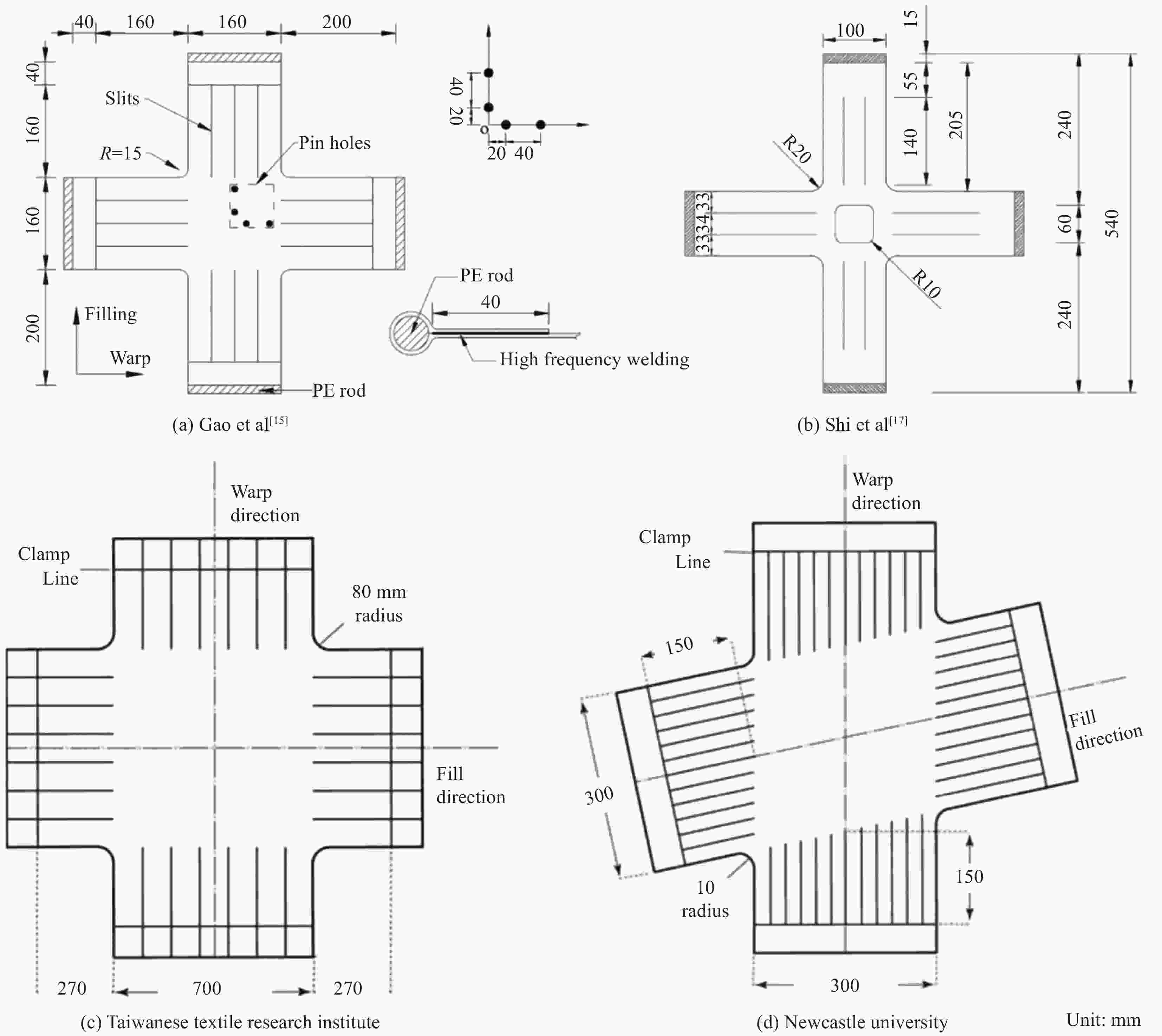
 下载:
下载:



